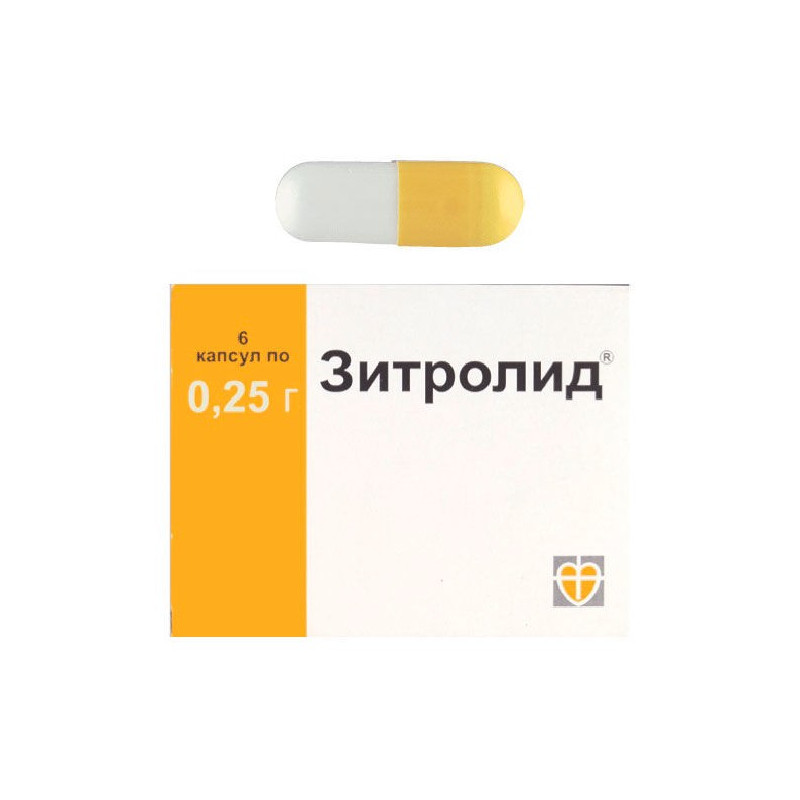



 All payments are encrypted via SSL
All payments are encrypted via SSL
 Full Refund if you haven't received your order
Full Refund if you haven't received your order
Zithrolide capsules No. 0, with white housings and an orange yellow or yellow lid. The contents of the capsules - powder from white to white with a creamy shade of color.
1 pill contains active substance: Azithromycin - 250 mg;
Excipients: Magnesium stearate, microcrystalline cellulose;
shell composition: gelatin, titanium dioxide, quinoline yellow, azorubine, ponso 4R;
6 capsules per pack.
Capsules solid gelatin, size number 00, with a white body and orange-yellow cap; the contents of the capsules are white to white with a yellowish tint.
1 pill contains active substance: azithromycin - 500 mg;
Excipients: magnesium stearate, microcrystalline cellulose;
shell composition: gelatin, titanium dioxide, quinoline yellow, azorubine, ponso 4R;
3 capsules per pack.
Nitrolide - An antibiotic of the macrolide group, is a member of the azalide subgroup. It has a wide spectrum of antimicrobial action. When creating in the focus of inflammation of high concentrations has a bactericidal effect.
A drug active against gram-positive cocci: Streptococcus pneumoniae, Streptococcus pyogenes, Streptococcus agalactiae, Streptococcus groups C, F and G, Streptococcus viridans, Staphylococcus aureus; Gram-negative bacteria: Haemophilus influenzae, Moraxella catarrhalis, Bordetella pertussis, Bordetella parapertussis, Helicobacter pylori, Legionella pneumophila, Haemophilus ducreyi, Campylobacter jejuni, Neisseria gonorrhoeae, Gardnerella vaginalis anaerobic microorganisms: Bacteroides bivius, Clostridium perfringens, Peptostreptococcus spp.
Active also in relation to: Chlamydia trachomatis, Mycoplasma pneumoniae, Ureaplasma urealyticum, Treponema pallidum, Borrelia burgdoferi.
Zithrolide inactive against Gram-positive bacteria resistant to Erythromycin.
Infectious and inflammatory diseases caused by microorganisms sensitive to the drug:
Nitrolide take 1 hour before or 2 hours after meals 1 time per day.
For adults at upper and lower respiratory tract infections appoint 500 mg / day for 3 days; course dose is 1.5 g.
At skin and soft tissue infections 1 g is prescribed on the 1st day and 500 mg daily from the 2nd to the 5th day (course dose - 3 g).
At acute urinary tract infections (uncomplicated urethritis or cervicitis) appointed once 1 year
At Lyme disease (borreliosis) for the treatment of the initial stage (erythema migrans) 1 g is prescribed on the 1st day and 500 mg daily from the 2nd to the 5th day (course dose - 3 g).
At diseases of the stomach and duodenum associated with Helicobacter pylori, the drug is prescribed for 1 g / day for 3 days as part of combination therapy.
Zithrolide is prescribed at the rate of 10 mg / kg of body weight 1 time / day for 3 days or on the 1st day - 10 mg / kg, then for 4 days - 5 mg / kg / day (course dose - 30 mg / kg)
At Lyme disease (borreliosis) children are prescribed at a dose of 20 mg / kg on the 1st day and 10 mg / kg from the 2nd to the 5th day.
Gastrointestinal: diarrhea (5%), nausea (3%), abdominal pain (3%); 1% or less - dyspepsia, flatulence, vomiting, melena, cholestatic jaundice, increased activity of hepatic transaminases; children have constipation, anorexia, gastritis.
Cardiovascular: palpitations, chest pain (1% or less).
From the side of the central nervous system: dizziness, headache, drowsiness; in children, headache (with otitis media therapy), hyperkinesia, anxiety, neurosis, sleep disturbance (1% or less).
From the genitourinary system: vaginal candidiasis, nephritis (1% or less).
Allergic reactions: rash, photosensitivity, angioedema.
Other: increased fatigue; children have conjunctivitis, pruritus, urticaria.
Hypersensitivity (including to other macrolides); hepatic and / or renal failure; lactation period (at the time of treatment is suspended); children up to 12 months.
Carefully - pregnancy (can be used when the benefits of its use significantly exceed the risk that always exists when using any drug during pregnancy), arrhythmia (ventricular arrhythmias are possible and the QT interval is prolonged for children with severe liver or kidney problems.
Sitrolid forte is not prescribed to children under the age of 12 months.
special instructions
It is necessary to observe a break of 2 hours with simultaneous use of antacids.
After discontinuation of treatment, hypersensitivity reactions may persist in some patients, which requires specific therapy under medical supervision.
Symptoms: severe nausea, temporary hearing loss, vomiting, diarrhea.
Treatment: drug withdrawal, symptomatic therapy.
Antacids (aluminum and magnesium), ethanol and food slow down and reduce the absorption of azithromycin.
With the simultaneous appointment of Warfarin and azithromycin (in usual doses), there was no change in the prothrombin time, however, given that the interaction of macrolides and warfarin may increase the anticoagulant effect, patients need careful control of the prothrombin time.
When used together with Digoxin, the concentration of digoxin increases.
With simultaneous use with ergotamine and dihydroergotamine increases their toxic effect (vasospasm, dysesthesia).
At simultaneous use with triazolam the clearance decreases and pharmacological action of a triazolam amplifies.
Azithromycin slows down the growth of, xanthine derivatives, including theophylline) due to azithromycin inhibition of microsomal oxidation in hepatocytes.
Lincosamines impair the effectiveness of azithromycin.
Tetracycline and chloramphenicol enhance the effectiveness of azithromycin.
Store in a dry, protected from light, out of reach of children, at a temperature not exceeding 25 ° C.
Shelf life - 2 years.
